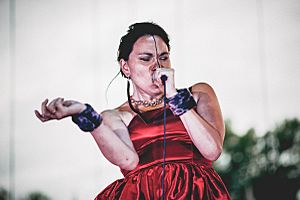Juno Award for Indigenous Artist or Group of the Year facts for kids

The Juno Award for Indigenous Music Album of the Year is a special prize given out every year in Canada. It honors the best album made by an Indigenous Canadian musician or band. The award is presented by the Canadian Academy of Recording Arts and Sciences, the same group that runs the famous Juno Awards.
Over the years, the name of this award has changed several times. It started as Best Music of Aboriginal Canada Recording in 1994. Later, it was called Aboriginal Recording of the Year and then Aboriginal Album of the Year.
Indigenous artists can also win awards in other Juno categories, not just this one. Some musicians, like the group The Halluci Nation, have chosen to compete only in the main categories instead of the one for Indigenous music.
Contents
History and Changes
Early Controversy
The award had a difficult start in its first year, 1994. A nominee named Sazacha Red Sky was accused of cultural appropriation. This means using something from a culture that is not your own without permission.
The family of Chief Dan George, who wrote the song she was nominated for, said she was not a member of their Tsleil-Waututh First Nation. They believed she did not have the right to record their song. A compromise was reached just before the awards show. Her nomination was changed to be for her whole album, not just the one song.
Debate Over the Category
In recent years, some Indigenous artists have suggested getting rid of this special award. They worry that it "ghettoizes" their music. This means it might make people think Indigenous music is only for a small audience and not for everyone.
However, other artists defend the award. They say it helps bring attention to Indigenous musicians who might not get noticed in the main categories. They argue that it's a great platform to showcase their talent to a wider audience.
Recent Developments
To better reflect its purpose, the award's name was changed again in 2020 to Indigenous Artist or Group of the Year. The Junos said this change was to help shine a spotlight on the achievements of Indigenous people.
Starting with the Juno Awards of 2022, the award was split into two new categories:
- Contemporary Indigenous Artist of the Year (for modern styles of music)
- Traditional Indigenous Artist of the Year (for music that follows older traditions)
Revoked Awards
Singer-songwriter Buffy Sainte-Marie won this award four times. However, in March 2025, all four of her wins were taken back. This happened after her Order of Canada was revoked because she could not provide proof that she was a Canadian citizen. This led the Juno committee to revoke her awards.
Notable Winners
Instead of a long list, here are some of the talented artists who have won this award over the years.
- 1994: Wapistan for Wapistan Is Lawrence Martin
- 1995: Susan Aglukark for Arctic Rose
- 1996: Jerry Alfred and the Medicine Beat for ETSI Shon "Grandfather Song"
- 1999: Robbie Robertson for Contact from the Underworld of Redboy
- 2003: Derek Miller for Lovesick Blues
- 2007: Leela Gilday for Sedzé
- 2010: Digging Roots for We Are...
- 2013: Crystal Shawanda for Just Like You
- 2015: Tanya Tagaq for Animism
- 2019: Jeremy Dutcher for Wolastoqiyik Lintuwakonawa
- 2021: Leela Gilday for North Star Calling
See also

